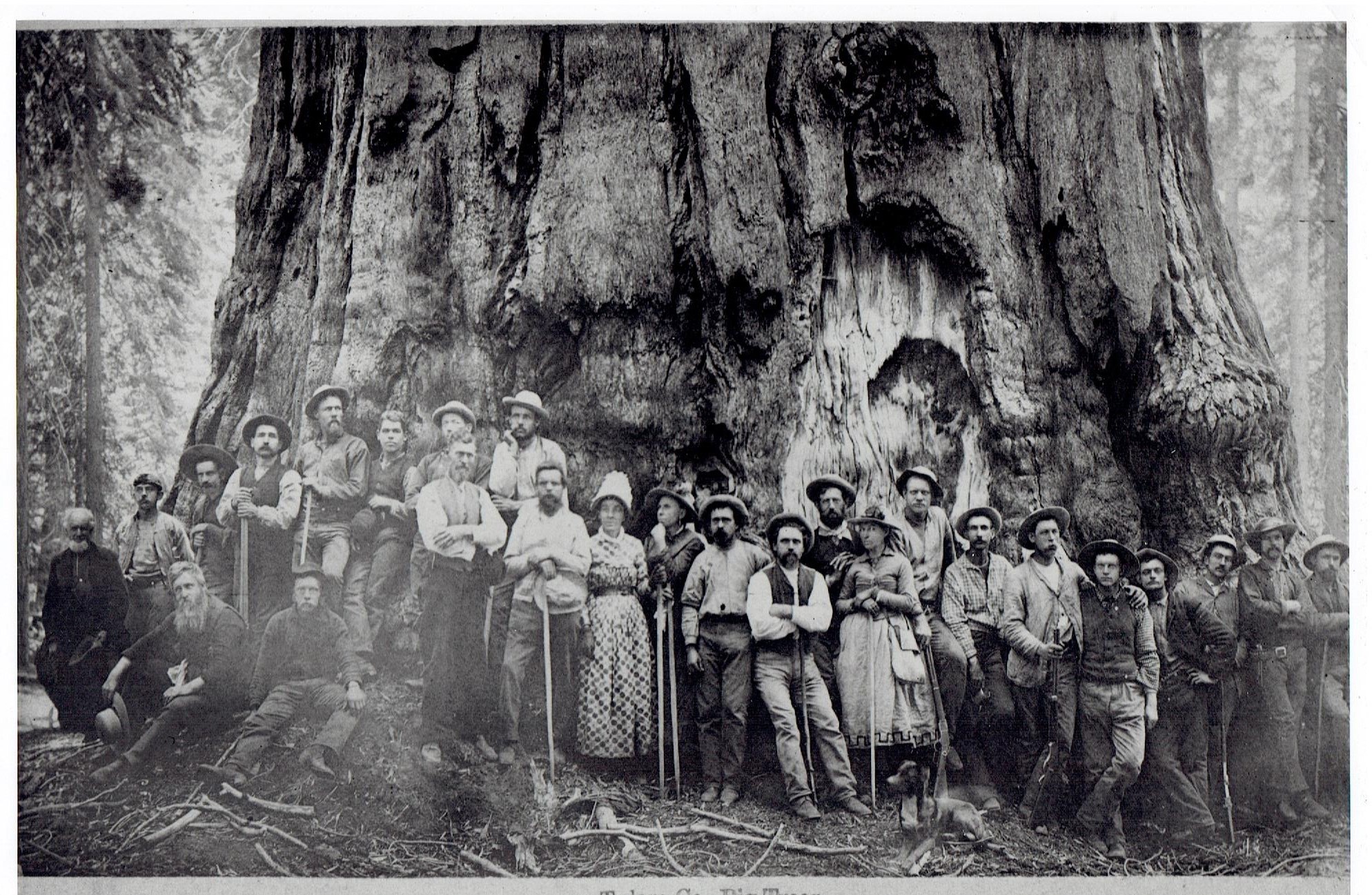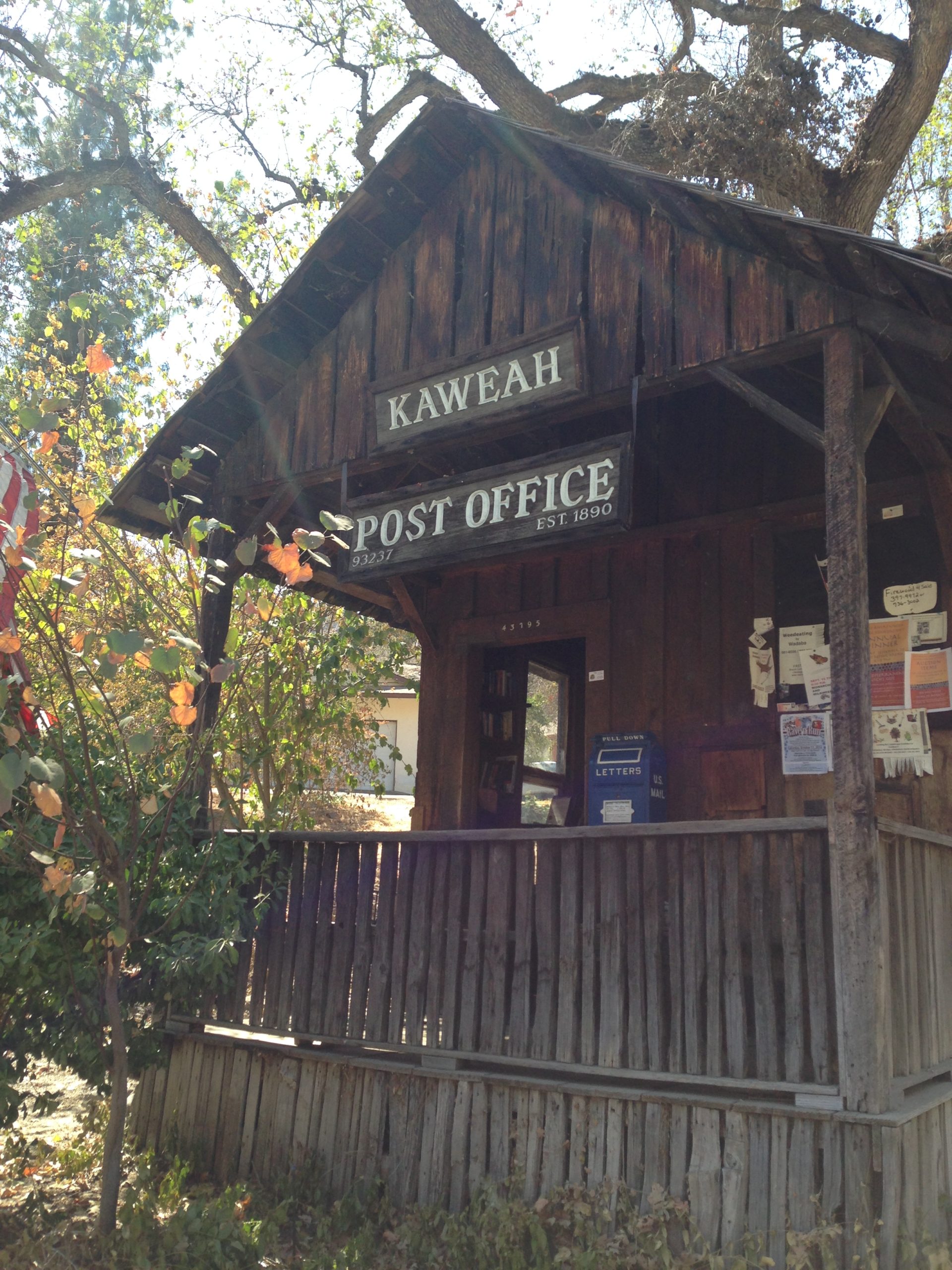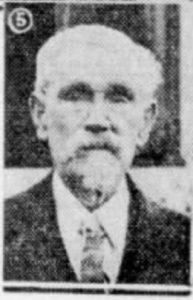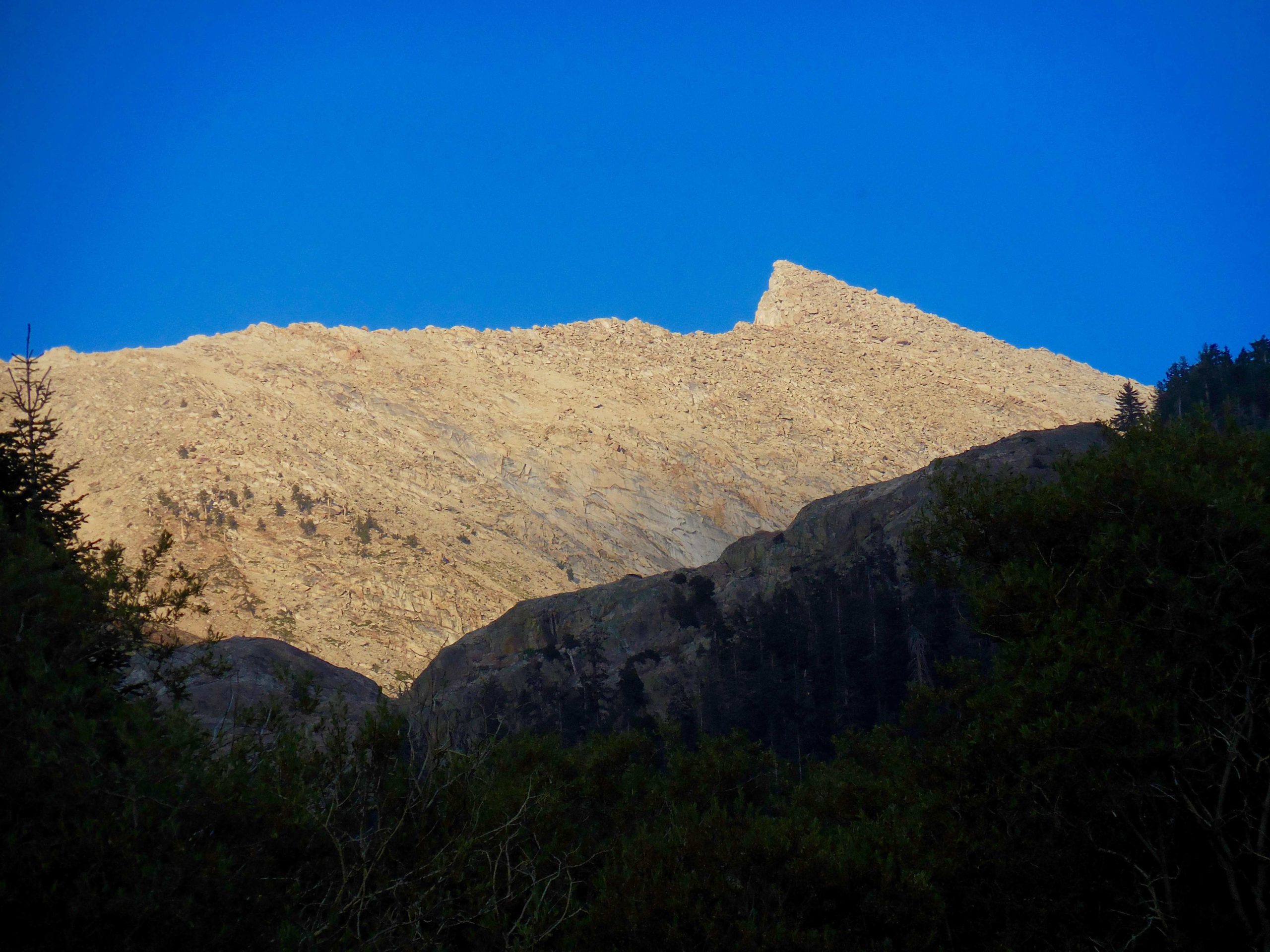
A History of the Kaweah Colony
Tag: Kaweah Colony

Once one of the smallest operating post offices in the United States, the Kaweah Post Office is a now a much-photographed destination that tells the story of adaptability after loss of a utopian dream.
This article is a compilation of multiple articles written by John and Sarah Elliott for The Kaweah Commonwealth on in 2015, 2016, and 2018 with an editorial update in in April 2021.
Almost daily, travelers make their way the three miles up North Fork Drive to visit the historic Kaweah Post Office. It is believed to be, in its own detached structure, the smallest continually operating post office in the United States.
In addition to being charming, the Kaweah Post Office has a remarkable story. It is one of the last vestiges of the Kaweah Cooperative Colony, a utopian project started in 1886 on the North Fork of the Kaweah River.
Part 1: History

The Kaweah Post Office was initially established at Advance, the Kaweah Colony camp four miles farther up the North Fork than its current location. It was established in 1890, the same year Sequoia National Park was created. At that time, Robert Kellar was 14 years old. He was the son of Charles F. Kellar, one of the founders of the Kaweah Colony in 1885 and surveyor and foreman during construction of the Colony Mill Road from 1886 to 1888. Robert’s mother, Caroline, who was the camp cook, and his older brother Carl were also part of Colony life.
Although the Kellar family left Tulare County before the Colony dissolved in 1891, the family returned in 1905 and lived in Kaweah (next to the present-day location of the Post Office) until 1918. At the turn of the 20th century, Robert was a local rancher and builder.
At some point, the post office was later relocated to Redstone Ranch (present-day Riata Ranch). In 1910, Robert rebuilt the post office near its present location along North Fork Drive.
Robert’s descendants have record of Robert building both the Kaweah Post Office and Sulphur Springs School. The school building is now a private residence at 42612 Kaweah River Drive.
The Kellar family also has photographs and a contract showing Robert reconstructed the Marble Fork Bridge on the Crystal Cave Road in Sequoia National Park and the River Inn Bridge in Three Rivers (which spans the Middle Fork to provide access from Highway 198 to North Fork Drive).
In 1926, postmistress and librarian Ida Purdy asked for the post office to be moved 800 feet closer to her home, which then served as the library.
In 1948, California officially designated the Kaweah Post Office as State Registered Landmark No. 389 owing to its association with the Kaweah Co-operative Colony. A first-day cover was issued and 5,000 cachets were mailed to collectors.
In 1999 Kathleen McCleary purchased the property. Since then, she has owned the Kaweah Post Office building and, until 2010, leased it to the United States Postal Service.
The U.S. postal service terminated the full- service post office contract in May 2010.
Part 2: Preservation
Any historic structure requires investment and dedication to preserve and maintain it. The Kaweah Post Office had needed additional care because it is actively used by over forty members of the community and welcomes hundreds of visitors each year. Unfortunately, it has also been victim of the drought, which toppled a sheltering oak, and thieves and vandals.
Kathleen McCleary has been owner, custodian, and protector of Kaweah Post Office since purchasing the property.
“It was sort of, ‘By the way, a post office comes with it,’” she said. “But soon I became aware of how this tiny little building is the very heart of the Kaweah community and what it means to the people who live here and who visit time after time.”
On Presidents Day February 16, 2015, two distinguished scholars in the field of stamp-collecting history visited the Kaweah Post Office. Calvin Mitchell and Daniel Piazza, assistant curators of philately at the Smithsonian’s National Postal Museum in Washington, D.C., stopped off at Kaweah as a part of a fact-finding tour of western postal places for an upcoming Smithsonian exhibit.
Both men are recognized experts in American history. According to Kathleen McCleary, who hosted the dignitaries for a picnic, the two researchers were tracing two postal continuums during their current tour: mail delivery on Route 66 (National Historic Corridor) and post offices that served national parks.
Not long after the visit, however, the future of the post office was jeopardized. On Monday, September 21, 2015, several large branches of an adjacent live oak came crashing down shortly after dark. The entrance to the 10-foot-by-12-foot wood frame building was damaged and the porch was completely covered by one huge branch that failed.
That same tree has stood as silent sentinel over the quaint little post office since the building was moved in 1926 to be near Postmistress Ida Purdy’s home. Though damage appeared extensive, the integrity of the 105-year-old wooden structure remained intact.
An outpouring of community support for the time-honored edifice was immediately evident.
A crew from Gene Castro’s Tree Service was on site the next morning and cleared the tree fall from the fragile structure. One large limb had penetrated the roof and it was removed without any further damage to the structure.
On Saturday, October 10, Kathleen McCleary and neighborhood volunteers staffed a booth during the Living History Day celebration at the Three Rivers Historical Museum.
“I want to thank all of the people who made donations; purchased the commemorative shirts, posters, and other items; and shared their love of our beloved ramshackle wooden box,” said Kathleen.
After a carefully executed restoration with like materials by general contractor Aaron Cluck, the structure is once again sound.
A new county-approved shake roof as be installed by Rascon Roofing just in time for the iconic post office to reopen on Monday, November 30, 2015 at 1 p.m., for the usual hour to distribute mail to postal box-holders.
On that day, the tiny Kaweah Post Office resumed what it’s been doing at one location or another since 1890. That’s providing mail service for dozens of patrons who wouldn’t want their mail delivered any other way.

This article was written by Phil Winser of the Kaweah Colony about a trip to Mineral King in August 1891.
Sawtooth at 12,343 feet towers over Mineral King and affords eye-level views of Mount Whitney, 14,505 feet.
After supper, on the evening of August 15, Comrades Westervelt, Clark, Winser, Al Redstone, Albie Martin, Ralph Hopping, and Willie Purdy, started for Mineral King and had a lovely moonlight walk through the pines. We found the rest of the party, consisting of Mrs. Brann, Mrs. Sully, Mrs. Westervelt, Jim Bellah, Ray Brann, Walter Boggs, and Miss Abbie and Emma Purdy, who joined at Atwell’s, camped by the river, and stayed up by the fire until late listening to George Clark’s violin and Al Redstone’s comicalities.
The ladies then betook themselves to their sleeping place – the wagon – and the rest of us spread down with our feet to the fire as closely as sardines in a box, for the nights at Mineral King are rather chilly. An early breakfast with the usual difficulties of camp cookery, a saddling of the two mules for the ladies to ride, by turns, and the start was made by 7:30; two of the party, the only wise ones, we came to think afterward, electing to remain in camp.
A few dilapidated wooden houses, a lot of tents and other camping accessories, tamarack trees and a very temporary population of about 200 people seemed to be the principal feature of Mineral King “town;” but it is the surroundings, and not the town, which are so interesting to the visitor. The mountain trail leading to our destination was a very blind one – rough and narrow – and the mule riders must have had great confidence in the sure-footedness of their steeds. At first we passed through dwarf manzanita, chaparral, and other low brush.
Higher up are a scattering of tamarack, juniper and pinyon trees looking terribly weather beaten and gnarled. We kept up a sharply rising valley between two ridges, the “Saw Tooth,” rising high before us.
About ten o-clock we reached the first patch of snow and of course snowballing followed. It was strange to see and feel it with a bright sun overhead and green grass, brilliant flowers, butterflies and hummingbirds all around.
Lower Monarch Lake with Sawtooth directly above.
At the foot of the high ridge which is crowned by the distinctive shaped pile we meant to scale, are two lakes – Upper and Lower Monarch – blue as the sky and cold as snow water. Here the mules were hobbled and left to enjoy a bountiful feed of grass, for the trail was no more. Now climbing began in earnest.
Rotten granite slopes at first where one’s feet sank in and backward at every step and the grade steep enough to require the use of hands; this was most tiring and solid rocks were preferable. From a distance the mountain appears the most barren looking pile imaginable, but almost at every step we found flowers of many kinds, their bright colors contrasting beautifully with the grey and brown of their sterile background. I never saw anything like the number of varieties of flowers. Even the minute snow fungus indigenous to the Alps and Sierra Nevada were there tingeing the snow patches with a light pink.
There is no regular route to the top of our mountain for there are few places where the rocks cannot be climbed. It appears to more a pile of broken pieces than a succession of solid cliffs; the climbing, however, was very hard on the ladies, and when the top was reached they were very tired. The view and grand breeze, however, seemed to do them a world of good and indeed it was worth all the labor of getting there.
I cannot hope to give an adequate description of the sight. All around were mountains of every size and shape, we apparently being on the highest peak and looking down on all. Mount Whitney could be plainly seen looking as though sprinkled with snow. Jim Bellah thought he could recognize Mount Shasta also.
The San Joaquin Valley was rather obscured by the smoke hanging in the air from the numerous fires; but the source of the Kaweah could be traced, and, it is said, that with a looking glass, on a clear day, the yellow of the cornfields can be seen, also the Coast Range and Pacific Ocean beyond.
The trail to Sawtooth today traverses the opposite side of the Monarch canyon.
Right below us, for on one side the descent is sheer precipice, was another of those deep blue lakes some thousand feet down and looking as though a pebble could be tossed into it; pine forests on some of the heights and patches of snow in the hollows and crevices of all. We were about 13,300 ft. above the sea, but a humming bird seemed quite at home there and buzzed by like a large insect.
After drinking in a scene the like of which I had never beheld before, we were obliged to tear ourselves away. The descent was accomplished in far less time than it took to go up; but it was not done without considerable exertion, and I suppose there was no one of the party but was heartily glad when the lakes were reached again and the accumulation of fine granite could be emptied out of boots, and droughts of that crystal water be taken.
The rest of the return journey was accomplished safely, but camp was not reached until after dark and we were very glad the two had stayed behind for supper was ready and we were ready for it